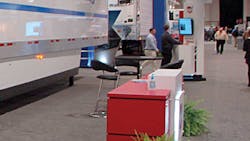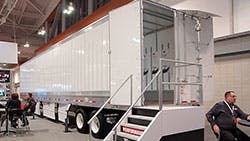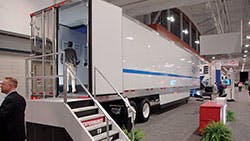Innovations in trailers and their components were prominent at the recent annual meeting of the Technology & Maintenance Conference held February 27-March 2 in Nashville, Tennessee.
Stoughton Trailers spotlighted a new way to produce a dry-freight van while also emphasizing the performance of its new rear impact guard that was successfully tested by the Insurance Institute for Highway Safety last year.
The company’s Z-Plate composite van and aluminum sheet and post trailers have been redesigned to reduce maintenance, improve durability, increase interior space, and increase parts commonality. Moving to standard components and parts allows for smaller parts inventory and provides more streamlined repair and maintenance flow.
The focal point of the design is a new top rail that provides a way to install roof bows without riveting. The extruded rail has a channel that runs the length of the inside surface. The heads of T-bolts are inserted into the channel and torqued in place. No drilling is required, and trailer dealers can replace damaged roof bows from inside the trailer without the need for exterior scaffolding.
Dry van corner posts and top corner castings are now identical left and right, reducing the number of parts needed for trailer repair.
Lower rails of the new Z-Plate also have been redesigned. The lower rail is 3-½ inches taller, allowing rivets to be placed 3-½ inches higher. By moving the rivets away from the scrape zone, durability is improved.
The trailer manufacturer also touted its new underride guard design which the company made standard in November. A Stoughton press conference held during the TMC meeting included an appearance by Marianne Karth, a safety advocate whose efforts have led the National Highway Traffic Safety Administration to strengthen its underride guard performance standards. Karth commended Stoughton for its commitment to highway safety. Stoughton’s new guard provides underride protection over the full width of the rear end of a trailer, without adding weight to the trailer and at no additional cost to the customer.
Two new vans from Wabash
Wabash National displayed a prototype dry van and former prototype refrigerated van that is close to being production ready.
The dry van is designed for logistics flexibility—but one that can be produced without clogging up production.
“It’s the ultimate in load securement,” says Brent Yeagy, president and chief operating officer at Wabash. “We secure the logistics between the panel seams. We can go below 16” spacing without burdening our manufacturing process. If the customer wants logistic track every six inches in the nose and 16 inches in the rear, we can do that. Wabash is in the unique position of being both the panel manufacturer and the trailer OEM.”
The prototype trailer that Wabash showed also included an integrated rub rail located high on the trailer where the sidewall damage tends to occur. Also: high-strength steel in the upper coupler—the same material used in the rear impact guard.
Also new at Wabash is the company’s Cold Chain refrigerated van with MSCT technology. The MSCT (Molded Structural Composite Thermal) trailer was a concept trailer a year ago. It has now gone into service with four launch customers.
“Last year we promised to bring to market a trailer that has 20% better thermal properties, that is 25% lighter, and has a 24,000-pound floor to market,” said Mark Ehrlich, product development manager. “It’s here.”
Thermal efficiency is achieved in part because the box has no metal to conduct heat.
“Sidewalls are bonded,” Ehrlich said. “There is no penetration of the sidewalls. Plus, the material is drastically different from standard. By molding it, we can add structure and strength through various types of fiber material which allows for weight reduction. And we achieved the 24,000-pound floor standard, one that can be loaded like a dry van.”
New tricks from a Great Dane
Great Dane Trailers unveiled a show trailer equipped with a list of advanced features. They include:
• The company’s new RIG-30 rear impact guard capable of protecting passengers striking the rear of the trailer, including extreme offset collisions.
• Mini-wireless rear mounted camera.
• Great Dane’s telematics concept, along with Great Dane back-up alarm with Grote four-in-one lamps.
• 18,000-pound floor system. The aluminum duct floor includes slip-resistant surface.
• Fastener-free bonded PunctureGuard scuffband.
• LED strip lights inside the trailer, mounted in cove molding that is installed without fasteners.
• Hendrickson AAT 23,000-pound capacity suspension equipped with TIREMAX PRO tire inflation system.
Vanguard shows new platform trailer
It’s tough to fit a round peg in a square hole. It’s even harder to squeeze a 53-ft platform trailer in a 40-ft shipping container.
Vanguard National’s new aluminum platform trailer does just that—with room left over for another trailer to make the trip, too. The key is the bolt-on rear section seen in this photo. The front of the main beams are a fixed length. When the rear sections of the main beams are bolted on, the result is a trailer that meets the customer’s desired overall length. Mating surfaces that are perpendicular to the web of the beams provide much of the strength, but reinforcements that extend ahead of and behind the joint help assure that stress at the joint is spread out across a wide area. ♦
About the Author
Bruce Sauer
Editor
Bruce Sauer has been writing about the truck trailer, truck body and truck equipment industries since joining Trailer/Body Builders as an associate editor in 1974. During his career at Trailer/Body Builders, he has served as the magazine's managing editor and executive editor before being named editor of the magazine in 1999. He holds a Bachelor of Journalism degree from the University of Texas at Austin.






